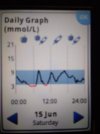Actually, I see it as more the other way around than the paragraph I highlighted in your post above.
For those with Type 2 diabetes, you kind of want to be making it harder for the body to obtain that glucose from food, so that it hits the blood stream more slowly and therefore your insulin response is able to manage it better. So, for example, sugar hits the blood stream very quickly 10-20 mins from eating, but all carbs break down relatively quickly and spike your BG (blood glucose) levels high usually within about an hour but it should be coming down by 2 hours. It takes quite a lot of insulin to deal with that sudden initial spike and bring it down. 100% of carbohydrate (excepting fibre which is indigestible carbohydrate) breaks down into glucose, so all carbs that are listed here in the UK on food labels release 100% of their glucose and do so relatively quickly. So the more carbs you eat, and the more finely processed they are, the bigger the spike usually is and the more insulin it needs.
If you don't eat enough carbs, the body starts to break down protein and fat to make glucose, because glucose is the fuel that all cells need. This process is much harder and much longer and only about 40% of protein and 10% of fat can be broken down into glucose. This only starts happening about 2 hours after eating and continues for 6-8 hours, but because it is releasing glucose very slowly, and at a much lower level, the body is better able to produce enough insulin to deal with it, because it needs less, plus it actually uses energy to convert the protein and fat to glucose, so this can help with weight loss as well as diabetes. This is a simplification of the mechanism by which a low carb or keto diet helps you lose weight and helps you manage your BG. So instead of spikes and troughs in your BG levels, you get more rolling hills. Less variability in BG levels is believed to lead to less risk of complications, so rolling hills are better that peaks and troughs that look like mountains or church spires.
I imagine this is hard for you to imagine since you will not have seen a BG graph but I have photographed a couple of my Libre graphs to try to demonstrate it a bit, although being low carb, I try to keep my BG spikes below 10 but when first diagnosed they went up to 15 or more on a daily basis and then came plunging back down to about 5, so they were very spikey....I am Type 1 so it is slightly different because I have to inject my insulin rather than use the insulin a pancreas produces but hopefully you will be able to see the difference....
View attachment 30645
View attachment 30646
I am not sure if that helps very much but hopefully it gives you an idea of what we are talking about. One is very up and down and the second one meanders more with less spikiness.
Don't worry about the red bits on the first graph. I had a couple of minor hypos but Libre exaggerates them.
🙄


